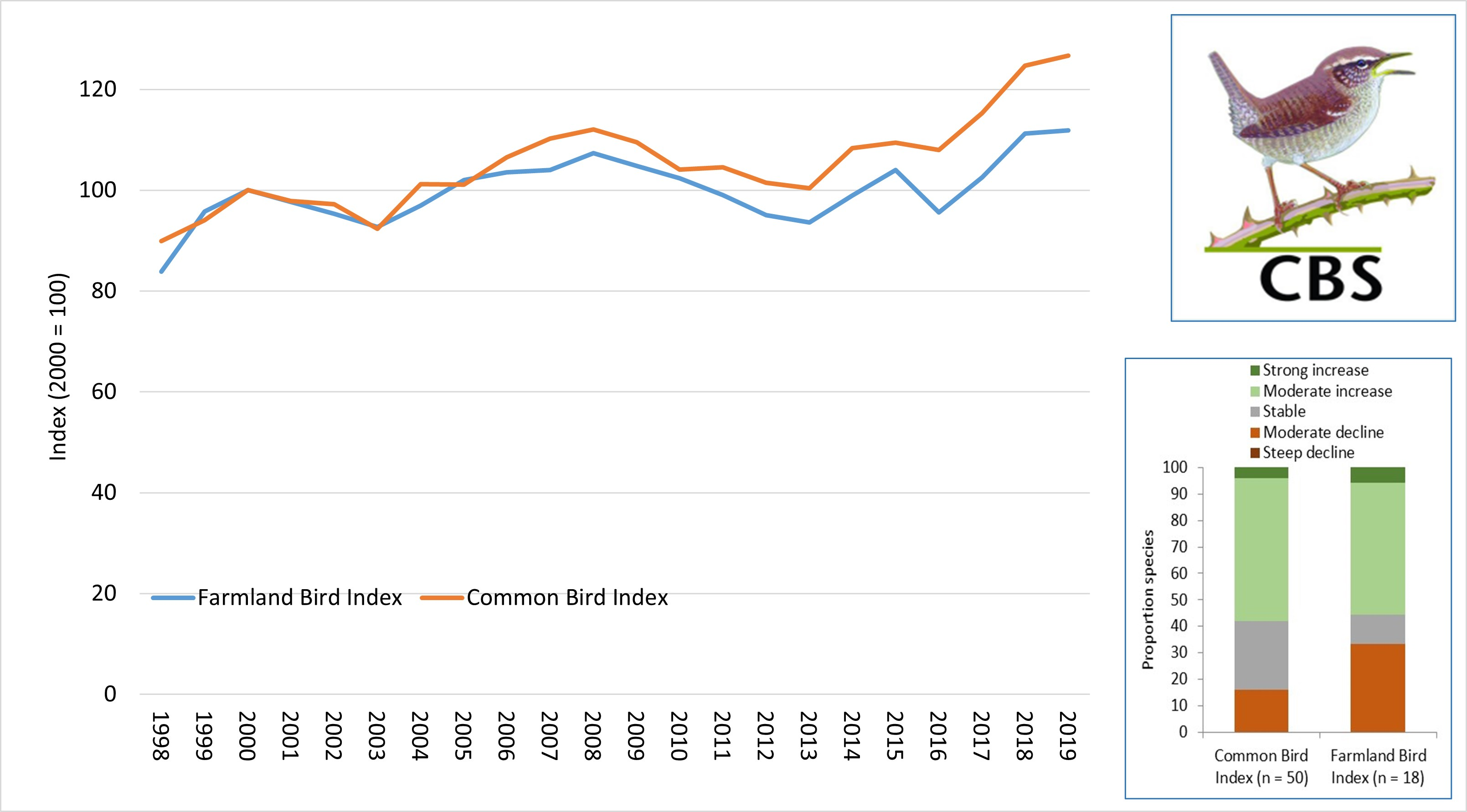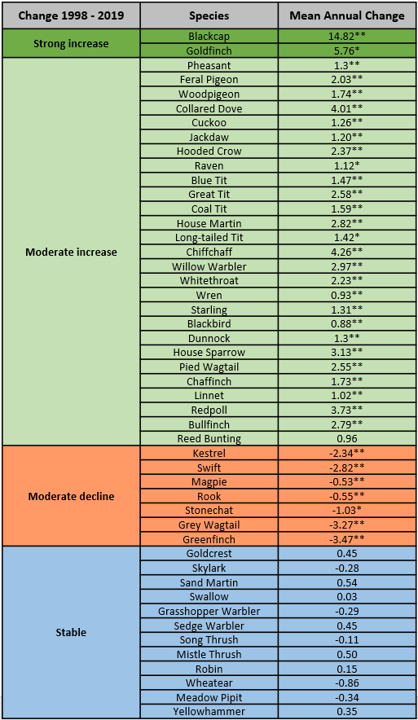| Current status | 2022 |  |
| Short term status | 2018 - 2022 |  |
| Long term status | 2012 - 2022 |  |
Click on the charts below in order to see the full resolution versions.
Across many habitats, birds are generally regarded as good general indicators of the broad state of wildlife and of the countryside, for both scientific and practical reasons (Furness and Greenwood, 1993; Gregory et al. 1995; Crowe, 2012). They are relatively easy to detect, identify and census, their taxonomy is stable, and the general level of understanding of their biology is quite high. As a group, they can be found across a broad range of habitat types and relative to other animals, are moderately abundant and of intermediate body size and life span. Consequently, their populations respond to changes in the environment at moderate spatial and temporal scales.
Across the 44 common and widespread breeding birds observed as part of the Common Bird Index (CBI), bird populations have increased overall (1998 – 2022). Since the baseline year of 2000 there has been a 43% increase in the population of these birds, on average. There has been population increases in 28 species, declines in 7 species and stable trends observed in the remaining 9 species.
Because BWI only include species that occur on average in 30 survey squares or more per year over the lifetime of the survey, the Common Bird Index represents our most commonly occurring bird species. The following species included previously, are now not included due to their occurrence being below the required threshold: Sparrowhawk, Stock Dove, Spotted Flycatcher, Wheatear, Treecreeper, Jay and Siskin. In 2022, the Rook and Starling were also excluded due to these species being colonial and flocking (where counts may include large numbers of juvenile birds). The CBS only aims to monitor adult populations.
Across the 14 birds included in the Common Farmland Bird Index (CFBI), populations have increased since 2000. Among the farmland birds there were increases in 8 species, declines in 4 species and stable trends observed in the remaining 2 species. Because BWI only include species that occur on average in 30 survey squares or more per year over the lifetime of the survey, the Common Farmland Bird Index represents the most commonly occurring farmland bird species. Several bird species that would have been included in a farmland bird index are now too scarce (e.g. Curlew, Lapwing) or extinct (Corn Bunting).
Despite the largely positive trends for many bird species, these trends should be interpreted in the context of significant large-scale declines in common bird populations across Europe during and prior to the 1980s (Pan-European Common Bird Monitoring Scheme, 2015). As such, the Countryside Bird Survey Report 1998 - 2019 recommends that although population increases of many species are welcomed, they should be viewed as the recovery of populations rather than increases. More information on how to accurately interpret the trends can be found here: https://birdwatchireland.ie/our-work/surveys-research/research-surveys/countryside-bird-survey/countryside-bird-population-indicators/
More information on BirdWatch Ireland can be found here: http://www.birdwatchireland.ie
More information on the Pan-European Common Bird Monitoring Scheme can be found here: https://pecbms.info/
References:
Crowe, O. 2012. Developing Birds and Indicators in Ireland. Report to the Heritage Council, Ireland. http://www.birdwatchireland.ie/OurWork/SpeciesHabitatConservationinIreland/BirdIndicators/tabid/1269/Default.aspx
Furness, R.W., Greenwood, J.J.D. 1993. Birds as monitors of environmental change. London: Chapman & Hall.
Gregory, R.D., van Strien, A., Vorisek, P., Gmelig Meyling, A.W., Nobel, D.G., Foppen, R.P.B., Gibbons, D.W. 2005. Developing indicators for European birds. Phil. Trans. R. Soc. B. 360: 269-288.
Pannekoek, J., van Strien, A. 2005. TRIM 3 manual. TRends and Indices for Monitoring data. Research Project No. 100384. Voorburg, The Netherlands: Statistics Netherlands. http://www.cbs.nl/en-GB/menu/themas/natuur-milieu/methoden/trim/default.htm
Pannekoek, J., van Strien, A. 2005. TRIM 3 Manual (Trends & Indices for Monitoring data). CBS, Voorburg, The Netherlands. http://www.cbs.nl/en-GB/menu/themas/natuur-milieu/methoden/trim/default.htm?Languageswitch=on
Lewis, L. J., Coombes, D., Burke, B., O’Halloran, J., Walsh, A., Tierney, T. D. & Cummins, S. 2019. Countryside Bird Survey: Status and trends of common and widespread breeding birds 19982016. Irish Wildlife Manuals, No. 115. National Parks and Wildlife Service, Department of Culture, Heritage and the Gaeltacht, Ireland.
Lewis, L. J., Coombes, R, H., Burke, B., Tierney, T. D., Cummins, S., Walsh, A. J., Ryan, N. & O’Halloran, J. 2020. Countryside Bird Survey Report 1998-2019. BirdWatch Ireland. Wicklow.


